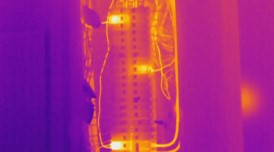Know Your Subject Matter
InfraMation 2012 Application Paper Submission
Peter Emmel & Jim Neilson
Pacific Gas & Electric (Diablo Canyon Nuclear Power Plant)
ABSTRACT
If you are going to be a reputable thermographer, it is vital that you know your subject matter. Period, end of story, it's as simple as that.
INTRODUCTION
In thermography, not everything you see through the viewfinder is cut and dried, especially in the electrical realm. The purpose of this presentation is to make you think about what it is you are seeing before you start with the Chicken Little act and scream the sky is falling. Ask yourself—do you truly know what you are looking at?
DISCUSSION
You are probably wondering from the title where this discussion is going. Well, it's going toward our creditability. As thermographers, we are the "go-to people" when it comes to identification of thermal anomalies. But if you don't know the operating characteristics of the components you are surveying, how can you make the proper call?
We all know that it only takes one wrong call to wipe out almost everything you’ve worked so hard to establish. Have you ever been in a meeting where somebody makes the wrong call? Do you think the decision makers ever truly trust that individual again? And, more importantly, do you want to be that person making the wrong call?
In these lean and mean times, organizations are looking for ways to cut the fat. Make some wrong calls, cost the organization time and money repairing something that didn't really need to be repaired, and your program or contract could be the next one on the chopping block.
THERMAL ANOMALIES...OR NOT?
We are going to look at some examples of what may or may not be "thermal anomalies." Without the appropriate level of post-inspection research, it's quite possible we would have made the wrong call, costing the company time and money. Worse yet, these errors could have ruined the creditability of our Predictive Maintenance Department, causing both past and future recommendations to be brought into question and possibly delaying future recommended repairs.
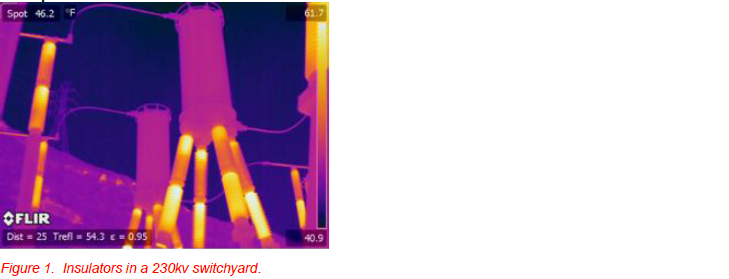
The insulators in Figure 1 certainly seem be to thermal anomalies, right? Wrong. Why? Because these insulators are made with a resistive glaze (RG®). RG® insulators use approximately 1milliampere to slightly heat the insulator surface a few degrees. According to the vendor this practice, "...discourages moisture accumulation which makes contamination conductive."
The old-style insulators were replaced with RG® during an outage and the thermographer was not informed. The old-style insulators never showed this condition so the initial assessment of our thermal image indicated degradation of the insulators. A questioning attitude, however, and the proper level of post-inspection research revealed that the new thermographic signature was normal. "Problem" solved.
Example 2
In the case shown in Figure 2, thermographers focusing only on the Delta T between like-for-like components would say it's a thermal anomaly. Is this a correct assumption?
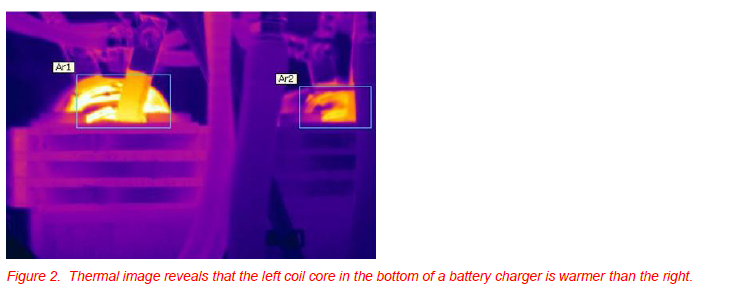
Yes, technically, that is true. However, after researching the battery charger schematic and discussing the issue with the component engineer, it was determined that the left coil is designed to draw more load and hence, has the higher operating temperature. Like-for-like was not the proper comparison in this case, but it took further investigation to find this out. Since this condition is acceptable for this specific charger, it is not a thermal anomaly.
Example 3
Per our company’s thermography guidelines, any current through equipment ground cables should be investigated. So, after looking at the two images in Figure 3, do you think is a thermal anomaly or not?
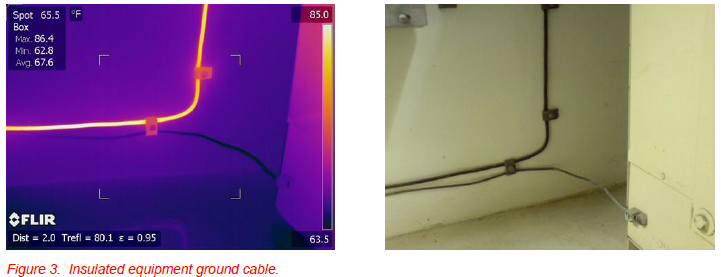
In this case, the correct answer is again no. The insulation on the equipment ground raised some suspicions. Further investigation revealed that the ground, even though it is tied into the station ground grid, is actually a return path for the cathodic protection system. Therefore, the current evident in the thermographic image is normal for this particular grounding scheme.
Example 4
The transformer bushing shown in Figure 4 ties the neutral windings from all three phases together and is a current carrying device. After reviewing the thermal image, a likely first assumption is that the two bolt assemblies on the right side are loose, causing the obvious thermal anomaly. True or false?
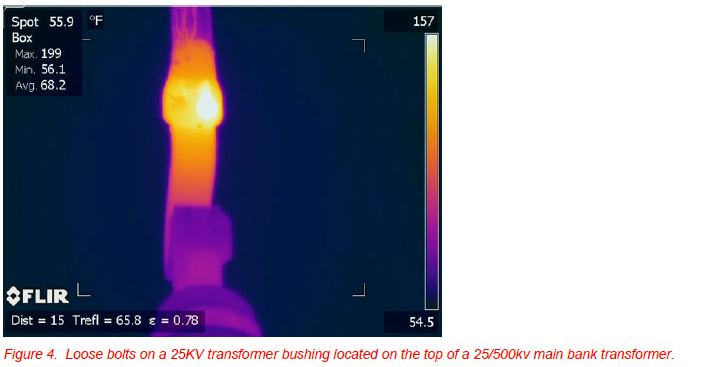
Again, the answer is false. Further investigation revealed a single source of current was going through the four bolted assemblies, effectively four parallel paths, thus creating a single-phase series/parallel circuit.
Now if you remember your electrical theory, you’ll recall that in a parallel circuit, voltage stays the same while current changes, and current takes the path of least resistance.
At the time of repair, it was discovered that the two bolt assemblies on the left were not torqued to specification, causing the current to increase through the good connections on the right which then appeared as the anomaly. In this situation, the good connection was more than likely to be incorrectly identified as the problem.
The majority of our thermographic surveys are on three phase systems where we are commonly looking for Delta T's between components that are carrying fairly balanced currents (three single-phase circuits running side-by-side so to speak.) In these types of systems, thermal anomalies usually indicate increased resistance of a poor connection. At first glance, the image in Figure 4 seemed to indicate the same type of problem. It would have been an easy trap to fall into.
When our Predictive Maintenance department was asked what we thought the main problem was, if we’d answered that the two bolted assemblies on the right were the loose connections, our creditability from that point on would have been in question
SUMMARY
We can sum up everything as follows: If you don't know what you are surveying, how can you make an educated call on what you are seeing?
The majority of our customers do not have the specific IR knowledge to make a call simply by looking at an image. They are relying on us as the trained thermographers to analyze the data and make the correct call. Sometimes this analysis consists of in-depth research into the subtle nuances of the particular component/system under scrutiny.
ACKNOWLEDGEMENTS
The authors would like to thanks the members of the Diablo Canyon Predictive Maintenance and Electrical Engineering departments for their support and input for this article.
ABOUT THE AUTHORS
Pete Emmel has been with Pacific Gas & Electric at Diablo Canyon Nuclear power plant since 1983. As the plant's Level III Thermographer, Pete's main Predictive Maintenance (PdM) responsibility is overseeing the Thermography program. Other PdM responsibilities include Tribology and Vibration data collection.
Much of Pete's career has been involved with plant maintenance. He has been a plant Maintenance Electrician, Electrical Control Technician, and I&C Control Technician.
Jim Neilson has been with Pacific Gas & Electric at Diablo Canyon Nuclear power plant since 2002, all of it being spent in the Predictive Maintenance department. Jim's main responsibilities include Vibration Analysis and component balancing, with a minor in Failure Analysis. Jim is also an ITC Level II Thermographer and is the primary backup thermographer.
Jim received his Bachelor of Science - Materials Engineering degree from California Polytechnic State University of San Luis Obispo


